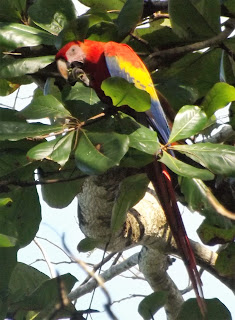 |
| Scarlet macaws squabbling at Playa Chamon |
Scarlet Macaws are awesome. That is an objectively true
statement. Everybody in Uvita loves them. Seriously. Gringos. Ticos. Everyone. People
hear their ugly squawk and they stop in their tracks, searching the trees for a
sighting. That’s because until recently they were extinct to this region –
along with tapirs, white-lipped peccaries and the jaguar. So, the gradual
return of these bright red, blue and yellow birds has been a source of
gratitude.
According to Jack Ewing, a local writer and owner of the wildlife
refuge Hacienda Baru, the macaws – or lapas, as they are called in Spanish –
disappeared from the area around Uvita and Dominical in the 1970s, due to
hunting and deforestation. At one time, most of the jungle here was cleared for
cattle farming in order to provide hamburger to North Americans.
In 1985, the deforestation peaked.
A number of factors combined to take the big profit out of cattle ranching, and property owners started looking for other ways to use their land. A gradual influx of foreigners interested in acquiring property triggered an upward curve in land prices. Many former ranchers were ready and anxious to sell. The new buyers weren’t interested in raising cows, they wanted to live in a natural environment. Also tourism was on the rise, and tourists wanted to see monkeys and toucans, not cows. Most of the new land owners let the pastures regenerate into secondary forest. In the tropics, when you quit chopping the weeds, the jungle comes back with a vengeance, and that’s what it did.
Then, in 1987, a new organization Amigos de la Naturaleza (ASANA) was created with the purpose of connecting
rainforest habitat that had been cut off from each other due to deforestation.
The
project is called the Path of the Tapir Biological Corridor (PTBC), because it
seeks to reunite two of the remaining habitats where the Beard’s Tapir still
exist. As the land has been restored, the animals have returned to the area.
According to Ewing, spider monkeys, squirrel monkeys, howler monkeys, pumas,
and ocelots, as well as many bird species have spread through the corridor.
As the jungle has replaced the pastures, the macaws have
been slowly moving back north from the Corcovado. The macaws eat beach almonds,
which grow especially thick around the village of Bahia Bellena and Playa
Chamon.
Even a year ago, sighting a pair was still an incredible
treat. Playing softball with a group of local ex-pats, a man who we’ve dubbed
Cigar Greg, pointed at a pair flying over and shouted across the field to his
girlfriend, “God damn, I love those fuckers.”
 |
| Playa Chamon |
The other day, Jeff and I counted 16 of them at one time.
The Tico men – farmers who live in the mountains - who are
constructing the villas on our property, refer to their wives as “mi lapas.” My
husband Jeff thought this was a sweet reference to the macaws beautiful
plumage. No, he was told, it’s because of their propensity for non-stop squawking.
No comments:
Post a Comment